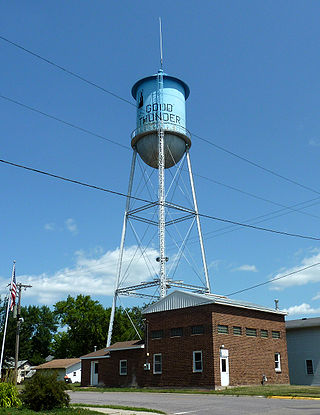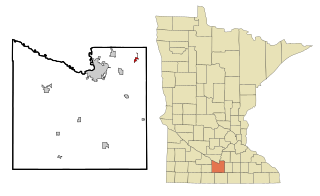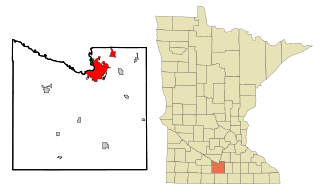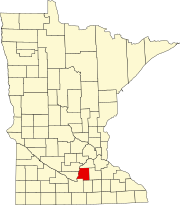
Le Sueur County is a county located in the south central portion of the U.S. state of Minnesota. As of the 2020 census, the population was 28,674. Its county seat is Le Center.

Brown County is a county in the U.S. state of Minnesota. As of the 2020 census, the population was 25,912. Its county seat is New Ulm. The county was formed in 1855 and organized in 1856.

Amboy is a city in Blue Earth County, Minnesota, United States. The population was 535 at the 2020 census. It is part of the Mankato-North Mankato Metropolitan Statistical Area. The city was founded in 1879. It celebrated its 125th anniversary in September 2004.

Eagle Lake is in Blue Earth County, Minnesota, United States. The population was 3,278 at the 2020 census. It is part of the Mankato-North Mankato Metropolitan Statistical Area.

Good Thunder is a city in Blue Earth County, Minnesota, United States, situated along the Maple River. The population was 560 at the 2020 census. It is part of the Mankato–North Mankato Metropolitan Statistical Area.
Jamestown Township is a township in Blue Earth County, Minnesota, United States. The population was 628 as of the 2000 census.
Lime Township is a township in Blue Earth County, Minnesota, United States. The population was 1,395 as of the 2010 census.

Madison Lake is a small city in Blue Earth County, Minnesota, United States. The population was 1,247 at the 2020 census. It is part of the Mankato-North Mankato Metropolitan Statistical Area.
Mankato Township is a township in Blue Earth County, Minnesota, United States. The population was 1,969 as of the 2010 census.

Mapleton is a city in Blue Earth County, Minnesota, United States. The population was 1,710 at the 2020 census. It is part of the Mankato-North Mankato Metropolitan Statistical Area.
South Bend Township is a township in Blue Earth County, Minnesota, United States. The population was 1,682 as of the 2010 census.

St. Clair or Saint Clair is a city in Blue Earth County, Minnesota, United States, located along the Le Sueur River. The population was 750 at the 2020 census. It is part of the Mankato-North Mankato Metropolitan Statistical Area.

Vernon Center is a city in Blue Earth County, Minnesota, United States, along the Blue Earth River. The population was 328 at the 2020 census. It is part of the Mankato-North Mankato Metropolitan Statistical Area.

Blue Earth is a city in Faribault County, Minnesota, United States, at the confluence of the east and west branches of the Blue Earth River. The population was 3,174 at the 2020 census. It is the county seat of Faribault County. It is home to a statue of the Jolly Green Giant. Additionally, Interstate 90 is centered on Blue Earth, as the east and west construction teams met here in 1978. As a tribute, there is a golden stripe of concrete on the interstate near Blue Earth. This draws an analogy to the golden spike set in the first transcontinental railroad. Approximately three miles south of Blue Earth is the Blue Earth Municipal Airport.
Kasota Township is a township in Le Sueur County, Minnesota, United States. The population was 1,487 at the 2000 census.

Courtland is a city in Nicollet County, Minnesota, United States. The population was 734 at the 2020 census. It is part of the Mankato-North Mankato Metropolitan Statistical Area.

Lafayette is a city in Nicollet County, Minnesota, United States. The population was 492 at the 2020 census. It is a farming community just outside the larger town of New Ulm.

Nicollet is a city in Nicollet County, Minnesota, United States. The population was 1,143 at the 2020 census.

Mankato is a city in Blue Earth, Nicollet, and Le Sueur counties in the state of Minnesota. The population was 44,488 according to the 2020 census, making it the 21st-largest city in Minnesota, and the 5th-largest outside of the Minneapolis–Saint Paul metropolitan area. It is along a large bend of the Minnesota River at its confluence with the Blue Earth River. Mankato is across the Minnesota River from North Mankato. Mankato and North Mankato have a combined population of 58,763 according to the 2020 census. It completely encompasses the town of Skyline. North of Mankato Regional Airport, a tiny non-contiguous part of the city lies within Le Sueur County. Most of the city is in Blue Earth County.

North Mankato is a city in Nicollet and Blue Earth counties in the State of Minnesota. The population was 14,275 at the 2020 census.


















